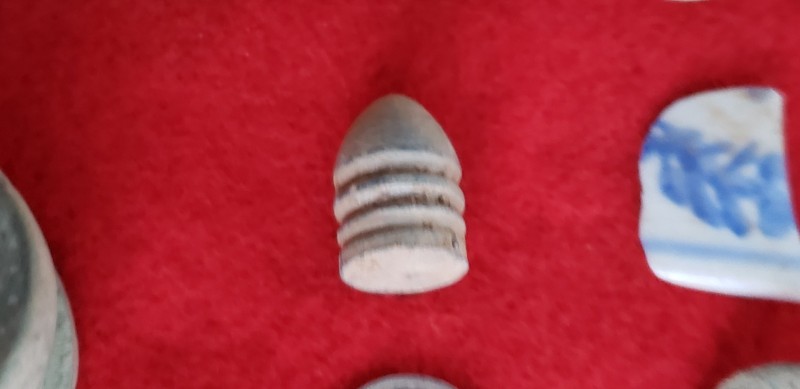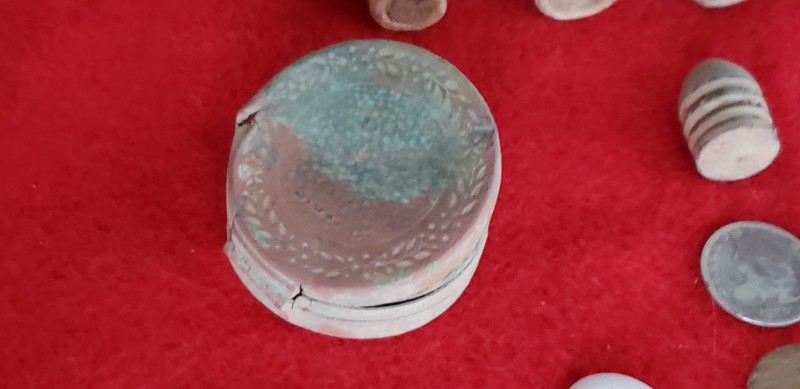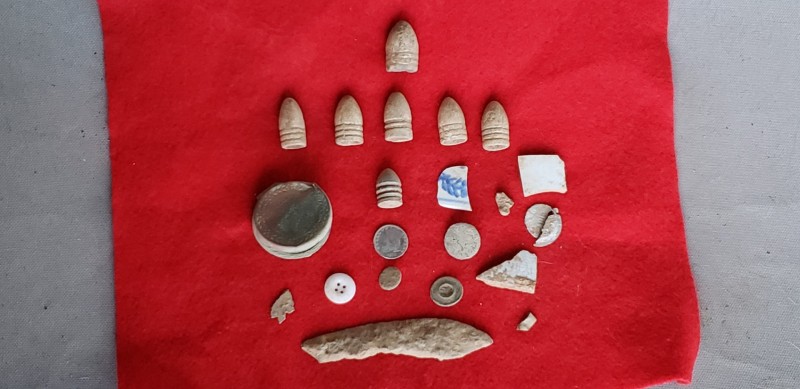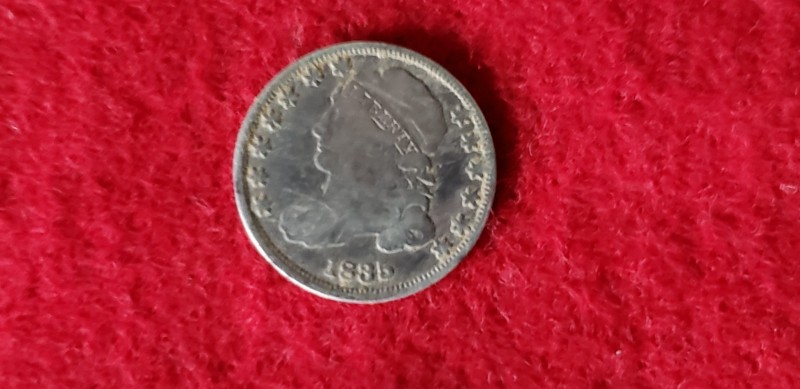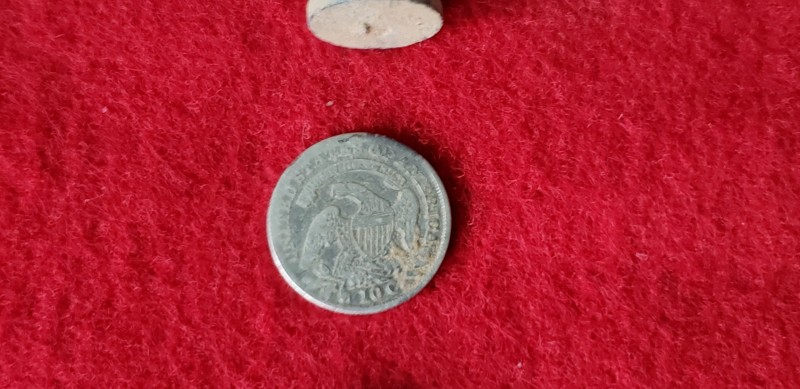-
Posts
6,143 -
Joined
-
Last visited
Content Type
Forums
Detector Prospector Home
Detector Database
Downloads
Everything posted by Chase Goldman
-
Went on a couple of hunts this past week trying to put my new Coiltek 10x5 Nox coil through its paces and then using my trusty Deus at my favorite relic farm site with numerous iron patches and high mineralization. Tested the Nox coil out on a Colonial site and scored a couple of keepers at decent depth in sandy soil including a flat Tombac button and a brass makeup case with a fancy "wreath" design. Snagged a tiny flat button there when switching over to the Deus and round 9" hf coil. in thick iron. A week later it was off to my relic paradise site we have been pounding regularly for a few years and steadily since November when I got the privilege to hit it after harvest and deep discing and snagged a $1 gold piece and about 30 other relics - perhaps my most productive single day ever. The site "refreshes" itself with every plowing. Anyway the finds were tailing off and this was the last trip before spring planting. Took the Deus out and got on the board quickly with a minie ball. Started pulling different types of minie balls including a .69 caliber "fatty", a confederate Gardner, and a really rare dropped .54 cal Merrill carbine, as well as some "generic" 3 ringers. But the highlight was an iffy high conductor signal - hoping for any silver at this point because they have been few and far between at this site, lately. Little did I know that I would be checking off a bucket lister that I have been hoping to snag for some time now. Flipped the plug and knew what I had with just a glimpse. Welcome to the finds pouch my freshly dug 1835 Capped Bust Liberty Dime. Some non-metallic eyeball finds and miscellaneous brass and lead fragments including a porcelain 4-hole button rounded out the day. Enjoy the pics...
-
Glad you got that 4th one so you could use that line. Congrats on the chains and the new phones!
-

Airline Travel With A Metal Detector
Chase Goldman replied to donP's topic in Metal Detector Advice & Comparisons
Probably good advice just to be on the safe side of not having a “misunderstanding” with TSA. But just to clarify, the fact is per FAA rules for Domestic travel (linked below) you ARE supposed to be allowed to pack devices with built-in Li Ion batteries in your checked luggage subject to capacity limits and taking precautions to ensure your devices cannot be inadvertently turned on. However, from a practical sense, that is really not something you can typically ensure with something like a metal detector unless you physically disconnect the battery (but leave it installed in the device) because it IS possible for the switch to be inadvertently depressed while in the luggage to to handling or stuff shifting around in flight. I typically have only travelled with the Deus which can easily be broken down and stowed in a carryon. If I was traveling with the Equinox, I would simply remove the control head and put it in the carryon and leave the shaft an coil in checked luggage. Tarsacci - just pull the removable Li Ion battery and put it in the carry on bag. Anyway, here are the FAA rules for US domestic flights (so this does not apply to international travel): https://www.faa.gov/hazmat/packsafe/more_info/?hazmat=7 Bottom line - maximum capacity you are allowed to bring on board per battery = 100 Watt-Hours (Wh) (an Equinox cell is 18.5 Wh, a GPX large cell is about 63 Wh). There is no limit to the number you can carry on board as long as the capacity limit is met and the battery remains installed in the electronic device. In addition, you can carry up to 2 spare batteries less than 100 Wh each, subject to AIRLINE approval. So if the GPX detachable battery packs are categorized as "spare" Li-Ion batteries can present a problem if the air carrier objects, which is their prerogative (as demonstrated in Steve's GPX Arizona detectorist example). All "spare" or standalone Li-Ion batteries must be carried on and cannot be in checked luggage. However, potable electronic devices (metal detectors?) that contain Li-Ion cells less than the 100 Wh capacity limit can be in checked baggage as long as the device is secured and is prevented from inadvertently being turned on and is protected from physical damage. International rules vary and can be more restrictive than US FAA rules as encountered also first hand by Steve, so your best bet is to discuss the situation with your international carrier ahead of time. HTH BTW Watt-Hour is a measure of energy which roughly tells you the potential for fire causing Li Ion material. A Watt-hour = Operating Terminal Voltage (Volts) x Current Capacity (Amp-Hours). So a 10,000 mAH (10 AH) capacity alone does not tell you the energy (the parameter of interest to the FAA and airlines), you need to also know the operating terminal voltage which is usually between 3.5 to 22 VDC depending on how the cells are connected -
The default tone settings (number, breakpoints, pitch, volume) for Beach 1 and Beach 2 are exactly the same by default and vdi’s for similar targets (e.g., nickels) are typically consistent across the board independent of the selected search mode. So unless you changed settings manually from the defaults, this statement does not make sense. Suggest you do a factory reset to get everything to the default settings and tweak from there. You may have adjusted something inadvertently and that is why your Equinox is not behaving well at the beach unlike your buddies who seem to have no issues based on your statements. Sometimes a user just doesn’t click with a machine. Maybe it’s just too complex or different than what you are used to (sparky and fast). So sometimes it’s best to quit trying to find fault with your machine (which is a known good beach performer) if it is otherwise not defective and banging your head against the wall and just go back to the CTX you keep comparing it too and seem to like. It does just fine at the beach, too.
-

What Would You Like In The Next XP Detector ?
Chase Goldman replied to relicmeister's topic in XP Metal Detectors
I have the Tarsacci and like it for very specific VA hot dirt situations, but still use the Deus and now the Equinox with the fantastic 10x5 coil more. XP's only real move is into multifrequency land but with ML on their fourth generation of multi and everyone else at the starting line, not seeing how anyone can keep up. -

What Would You Like In The Next XP Detector ?
Chase Goldman replied to relicmeister's topic in XP Metal Detectors
Chuck you do have a knack for painting vivid (though sometimes disturbing) pictures using just words. -
It was an interesting story and glad you posted it. Guess I read to far into why you chose to bold only a portion of my statement. What would be interesting is how the dairy farm actually discovered the stray voltages/currents existed. Besides the cow “illnesses”, were they detecting EMI on radio equipment, had any visual or audible indications of arcing, or used a field strength meter or voltmeter to measure for EMI fields or stray voltages? What clued them in that the cows were getting sick because of electricity?
-
Good point. I think it can go either way when it comes to EMI depending on the type - so a more general statement of simply adjusting recovery speed either way to see if it has beneficial effect is probably a better way to put it. One thing I do know is that reducing recovery speed generally increases ground noise. So you can be trading one undesirable effect off on another undesirable effect.
-

Which XP Deus Coil Is The Deepest
Chase Goldman replied to Kaolin washer's topic in XP Metal Detectors
Orx normalizes all IDs to the 18 khz reference regardless of selected operating frequency on every coil (including the HF coils) as Jeff mentioned above. Which is a good thing as the 2 non-ferrous tone breaks associated with the coin modes are fixed (not adjustable). Orx just missed being a true Deus killer because it is limited to 3 fixed tones. If they simply added pitch and full tones I could honestly say there would be little reason to upgrade to the Deus even accounting for all of the other Orx simplifications vs. Deus. Still better than the Deus lite configurations, it is merely a very good backup to the Deus IMO. -

Which XP Deus Coil Is The Deepest
Chase Goldman replied to Kaolin washer's topic in XP Metal Detectors
It's rare to shift to the sub frequencies at all, but even if you did, the impact would be practically NIL on TID because the shift is much, much less than a kilohertz from the base frequency. With 5 frequencies to choose from on the X35 coils, I've never seen the need to shift at all unless it was to extend to the very lowest or very highest possible operating frequency. -
I like how you bolded the lead phrase when you quoted me but basically ignored the rest of that sentence which basically addresses the situation in your news clipping... I don’t know if EMI signaled the imminent failure that resulted in the stray voltages that caused the cattle to become ill, but I did say that would be one of the cases where the power companies would care. Thanks for cherry picking a portion of my statement out of context to use it to make a point I already made. Weird. They are not the same thing but often EMI is generated as a result of the component failure that would cause the stray voltage issue either due to arcing or from the EM fields generated by the currents flowing due to the stray voltages. But the opposite is not necessarily true. EMI can be generated by electrical equipment that is functioning perfectly fine. In that case the electric company isn’t going to do anything about that just because it interferes with your metal detector or AM radio. That was my original point.
-

Which XP Deus Coil Is The Deepest
Chase Goldman replied to Kaolin washer's topic in XP Metal Detectors
Deus allows for multiple custom programs so you can set up a custom program for each frequency you want to use with the tone breaks set accordingly consistent with that frequency. By switching between programs using the plus/minus buttons on the keypad, you simultaneously change the operating frequency and shift your tone breaks accordingly so a nickel always sounds same even if the TID changes with frequency. HTH. -
My real world farm fields have hundreds of square nails and pieces of corroded tin ration cans. Iron bias helps to turn many of those nails and ration can pieces into pure ferrous signals. It would be a really, really low probability that it would also mask a non- ferrous. In other words, iron bias might reduce the adjacent non-ferrous target signal into an iffy signal or blip as was demonstrated in your video or have no effect whatsoever on the non-ferrous target. That might be worth investigating but it would be unlikely for IB to turn it into a totally ferrous target signal. Heck, bent square nails still false with IB applied. My targets are not primarily coins. They are brass and lead and sometimes gold and silver coins and rarely I do have to deal with modern aluminum trash. IB does not create a null signal for me because I turn disc off, so if there is a ferrous or non-ferrous target under the coil and within its depth limit I will hear it. I don’t know what you mean by not hearing it. If it is full ferrous, I have a decision to make to dig or not dig. If it is iffy, I interrogate it further and then make a dig decision. If it is a pure dig me signal, well then I dig it. Iron bias is a feature of Multi IQ I take advantage of to get rid of some falsing, I am willing to roll the dice that I might walk over a masked ring or rare button, in the mean time, I also haven’t dug a hundred falsing nails. A lot different than easily scooping falsing bottlecaps out of the sand, so I get why you wouldn’t mind doing that to ensure you don’t miss a ring. So yes I will do as I wish. Thanks. Like I said before, different situations warrant different detector settings.
-

What Is The Purpose Of The Arrow?
Chase Goldman replied to Earth sweeper's topic in Minelab Equinox Forum
As far as I can tell, it is just a coil visual centerline marker refence to aid in target detection (points down the most sensitive region of the coil where the two back-to-back D's overlap and as manual pinpointing (wiggle or x method) aid. -

Which XP Deus Coil Is The Deepest
Chase Goldman replied to Kaolin washer's topic in XP Metal Detectors
Frankly, the answer to this question is actually "it depends". But first lets dispense of the X35 11X13 coil. Too heavy, no real performance benefit, and the increased swing coverage is not worth the added weight and shaft stress and potential loss of small target sensitivity. Especially if you considered the exorbitant cost of Deus coils due to the electronics embedded in them. Theoretically, the 11" is deepest but I am not sure it is really a measurable difference. First of all, the ground conditions come into to play - in hot ground you are probably better off with the 9" round or even the 9x5 elliptical because the 11" will pick up more ground noise. It's only real advantage seems to be swing coverage. As others have said, the Deus just seems to be optimized around the 9" round coil. My favorite coil is the 9" HF coil but it is limited to a minimum frequency of 13 khz which is a great "all around" frequency but you can get better depth at lower frequencies. I like the HF coil because it accommodates 28 khz which to me seems to be a sweet spot frequency for relic hunting. A better all around coil is perhaps the 9" x 35 because you can dial it down to less than 4 khz for max high conductive target (e.g.,, silver coin) depth. The 9x5 obviously offers great separation but it also gets decent depth for its size and ok ground coverage, but it is certainly not the "deepest" coil. HTH -
First of all to answer one of your later questions first, utility companies do not care much about EMI unless it is signaling an imminent component failure or if one of their industrial customers complains that the EMI is causing some sort of plant operations issue. Other than that, it is just a something detectorists have to deal with. I think the issue with Equinox is that Multi IQ is the susceptible to EMI in general because the input signal filtering has to allow a wide frequency bandwidth of signals into the signal processing "circuitry". To mitigate EMI the steps you should take are (some are obvious, I you probably already know this): Noise Cancel Ground Balance (technically doesn't mitigate EMI but ground noise) Lower sensitivity as necessary. If you feel you have to lower sensitivity TOO much then: Try increasing recovery speed. Switch to another Multi IQ mode (modes which use higher weighted frequencies tend to be less susceptible to power line/transformer noise like the "2" modes and Gold modes, sometimes the Beach modes are also less susceptible even though they have lower frequency weighting - there are no absolutes so try all the modes to see how they do - remember you have to noise cancel each mode separately) Switch to single frequency (higher frequencies tend to be less susceptible to power line/transformer noise, remember to noise cancel for each frequency you try out). Notch offending TIDs (kind of a last ditch effort if you simply want to try detecting the site) Visit the sites at different times of day. Sometimes the noise is more intense during a normal working day and sometimes weather/humidity causes more arcing an EMI. HTH
-
No links provided in this thread so not very helpful but I did go out of my way to find a video bklein posted in a thread that was basically a carbon copy of this one... Glad I did make the effort to find the video because it basically epitomizes my issue with such video demonstrations of "concerns"... Yes anyone can set up various target configurations (especially in 2 dimensions) that will cause any detector to miss a target under specific, precise, and worst case orientations of targets and the approach angle of the coil swing. Down the barrel of a large rusty nail, of course the dipole targets disappear because of the way the magnetic lines of force of the nail field converge over the adjacent targets and IB will tend to favor that mixed signal and push it into the iron range. However, what I heard was an iffy signal at the swing ends and I would definitely stop to investigate it as I would with most full up iron signals, just to see if I could coax out a non-ferrous squeaker. To that point, no skilled detectorist swings the coil as uniformly as you did in the demo. Everything has to line up perfectly to make those targets disappear. If you think about the real world situation that has to occur, the odds start to stack up AGAINST you actually encountering this situation in real life. First, all the targets have to end up in this perfect straight line configuration. Even if you take just the nail and quarter or nail and ring, they have to lie in the same plane, most likely. Then you also have to have the detectorist happen upon that target group at the precise swing angle across all targets for the two non ferrous to disappear. Any deviation and at least one of the targets will likely be picked up. That's why if really don't want to lose sleep over missed targets,, you grid from two angles, ensure swing coverage by overlap and vary your swing tempo. Finally, from what I heard on those repeatable blips, I would not just walk over that target. Any ferrous grunt with non-ferrous blips I evaluate by rotating around the target and using small coil wiggles (this is called coil control and is a learned detectorist skill and second nature to me). I to try to coax those non-ferrous blips into resolvable target signals, and even then, will likely dig to investigate what is going on. In the mean time, I welcome that iron bias mitigates the falsing of lone pieces of iron and keeps me from wasting my time with pure ferrous signals if short on time or if I do not want to tear up a site with unnecessary plugs. Or looking at it another way, the miniscule chance of walking over the masked ring is compensated for by more swing time giving me a fighting chance to cover more ground in a fixed amount of time vs. chasing "false" ghosts which equates to more recovered targets. In other words, just not losing sleep over the miniscule chance that IB will cause me to walk over a target just as I am not losing sleep over missing a stack of silver dollars that null out the coil in multi (a known quirk) or sounding like iron wraparound (another quirk) or fooling myself that I am going to find a cache of gold coins or will win the lottery. Extreme low probability events are not my concern and masking caused by IB falls in the same category. But that's just me. The beauty is ML provides you plenty of options and one of those is running IB=0, so if you are really nervous about masking and don't mind digging repeated falses, knock yourself out. That's a personal choice and is what we do with metal detectors, choose settings that best balance offsetting areas of concern. Every detectorist has limits and values different characteristics of a detector differently for different situations. Disc vs. All Metal, Depth vs. Separation/Recovery, Depth vs. EMI or Ground Noise, TID stability vs. repeatability vs. resolution vs. accuracy, Mid Conductive sensitivity vs. raw depth, coil depth vs. small target sensitivity vs. weight vs. swing coverage and so on. I have made my value-based decision on IB and it is "biased" to a 6 setting as being more value than a 0 setting with minimal downside.
-
Doubt it will be too dramatic a transition. IMO the 15" is a tad too heavy for what it brings to the table as an every day coil (might be good for water hunters, though, or max depth power coil in mild soil). Great haul by Gerry, but the 11" and 12x15" ML coils would have likely gotten those coins also - Gerry got onto a hot spot as best as I can tell. The 10x5 will probably steal away a lot of 6" round coil fans because it has more utility with its decent swing coverage without giving up much in terms of separation and weight vs. the 6" round. So yeah some 6" coils will be looking for new homes. But overall, the Coiltek coils simply fill some situational gaps left open by the limited choice of ML accessory coils rather than outright replacing them.
-
Can't tell if you were just busting Gerry's chops, but the nickel IS silver - a 1945 War Nickel from the pic. Nice finds Gerry. Probably more a function of the site than the coil, but it shows the coil has what it takes to get the job done. I figure the 15" is going to give you probably on the order of 2" additional depth under good soil conditions for coin sized targets. I was surprised at the decent depth I was getting in sandy, mild soil with the 10x5. No spectacular finds but recovered coins and buttons as deep as 7 to 8" , which is not too shabby for a coil that is an inch narrower than the 6" round. So I get as good or slightly better depth than the 6" and similar separation, with decent swing coverage. Happy with my Coiltek so far.
-

Historic Random Hunt
Chase Goldman replied to F350Platinum's topic in Metal Detecting For Coins & Relics
T keys are always cool finds. Looks like you've got some research ahead of you to find Mr. Coleman's story. Good luck. -
Congrats on the coins. Just to be clear, Kaolin - were you using Deus Fast (Coins Fast is not a Deus Program) at 8.4 khz full with an X35 coil? What size was the coil, btw? Full tones is a great tool in modern aluminum trash, because the tonal nuances really help to bring out the irregular tone distortions associated with mangled aluminum slaw and bent pull tabs. Pristine tabs will still fool you, though. If I am in thick iron, I prefer pitch audio with discrimination which basically sets up as a two-tone approach with iron volume providing the iron grunt tone for anything below the ferrous tone break (disc setting - I usually set it between 7 and 10, 7 if I can get away with it (i.e., if most iron rings up at 6 or below), 10 if I have to. In this pitch set up, anything that registers above the ferrous tone breakpoint results in a VCO pitch audio signal which really stands out, especially on "squeaker" iffy targets. Full tones is just too much in iron, frankly and you can't run full tones with any discrimination if you want to hear the iron. Why run with discrimination? It helps to mitigate ferrous down averaging and helps the horseshoe display accurately display target depth and ferrous vs. non-ferrous. Tom I know what you are driving at regarding the Deus affinity for ringing up large, flat iron as a sweet high conductor both in tone and ID. However, regarding your statement on "seeing through the iron" you can never be truly sure a non-ferrous is being masked if you don't dig the iron. But as far as unmasking in iron, I find using the pitch tones approach above, to be most effective in umasking of non-ferrous in thick iron. It really pulls out squeaker iffy signals and manipulating the target with the spade (simply twisting the blade in the dirt or removing some dirt) helps to potentially separate the keeper from the iron masker, which helps firm up a dig decision even even further without having to necessarily dig the iron. But you have to get that iffy squeaker clue in the first place (otherwise you are simply just digging it all). It doesn't help eliminate flat iron from sounding non-ferrous, but having some disc applied tends to mitigate the effect somewhat, though it is really marginal. So that's the point - trying to give you a better chance at hearing those partially masked squeakers. HTH
-
BTW - I consider the link below to be the definitive iron bias thread. Some of it slightly contradicts my conclusions regarding whether IB can exacerbate masking non-ferrous in the presence of ferrous but it was the thread that opened my eyes on the usefulness of IB F2. I am still trying not to over think it and just keep IB at 6 to simply balance the indisputable upside of IB against the debateable downside of using the feature. IB 6 for me all the way. As Steve said above, the best adjustment you can make when detecting is simply cranking up your ability to get yourself onto a primo site through research and people skills and then efficiently cover every inch of ground you can with your coil while you are there (tactics vary depending on whether it is a one off visit or have lifetime privileges). Much more effective and valuable than any detector tweak.
-
6 - When I say I use the default, I mean I use the default. I have been impressed where ML has set the defaults on Equinox and I honestly don't stray much from them in any search mode other than to set sensitivity appropriately and the number of tones to my liking (usually 50 when relic hunting, 5 at the beach or in a park), perhaps a tweak to recovery speed a tad to calm things down (meaning I usually increase recovery ABOVE the default) and ensure I always noise cancel and do an auto Ground Balance. I either have a Gold Mode program or a single frequency variant of the mode I am searching with stored in the Custom Profile slot to enable quick target interrogation - single frequency target interrogation is where I really notice the comparative IB "ON"/"OFF" target response. I personally do not think IB = 0 in either FE or F2 mode turns IB completely off when using Multi IQ - it simply minimizes the effect - so if you really want to know what the minimally filtered and processed target signal sounds like, you have to go to single frequency. But that's really neither here nor there, I suppose.



